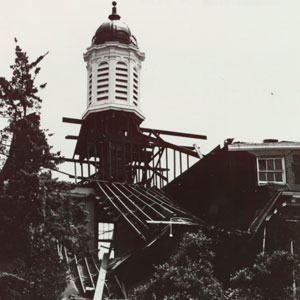
Prior to its demolition in 1968, Austin Building was the campus icon, a grand architectural expression of the school and its devotion to education and progress. Admittedly, however, by the early 1960s, the building, one of the first four built, was the subject of disparaging humor. Students claimed that its floors were so uneven that they became sea-sick walking through it. Others warned that it was simply unsafe. Inspectors advised against trying to save the building, mainly because it lacked a structural steel framework. Years before its demolition, a new classroom space, “new Austin,” was built to provide a more modern space for learning. Finally, the university made the decision to contract demolition of Austin and Wilson Dormitory east of it. High-rise women’s dorms were initially planned, but later the university decided to build a fine arts center on the vacant site named after ECU president, Dr. Leo W. Jenkins.
Aware of the building’s imminent demise, the campus yearbook, The Buccaneer, featured a quasi-cubist, vertical section of it on its cover. The somewhat fractured section rose like a rocket ship, from the front entrance to the towering cupola above. The image hinted that old Austin, though picturesque and grand, would not stand long. In July of 1968, sixty years after the ground breaking ceremony that launched the campus, its central monument was demolished. A local reporter noted that someone had written, in a neat hand on a classroom blackboard, “She lived to serve.” Another blackboard read, “Be gentle in tearing her down. She’s old and has seen more than you will ever see.”
When Austin came down, ECU was undergoing change, conflict, and controversy. University status was achieved, but only with a fight. An aggressive black student movement was emerging, ready for a struggle for a better campus. And ECU’s push for a medical school continued. Nationally, America mourned the loss of Dr. Martin Luther King and Senator Robert F. Kennedy, cut down in the spring and early summer of 1968. Campus headlines inevitably shifted away from the fate of old buildings to the crucial challenges ahead. And 1968 was a presidential election year.
At ECU, the campus focused on the future, not the past. Nevertheless, the year after Austin was razed, The Buccaneer juxtaposed the building in its prime with the edifice destroyed. A eulogy – an excerpt from Gerard Manly Hopkins’s “God’s Grandeur” – was added.
“Generations have trod, have trod, have trod;
And all is seared with trade; bleared, smeared with toil;
And wears man's smudge and shares man's smell: the soil
Is bare now, nor can foot feel, being shod.”
Succinctly, the yearbook observed, as a conclusion, “clean out the old, bring in the new,” By 1972, The Buccaneer, looking back on the school’s sixty-five year history, was more poetic and philosophical, noting that “in a very real sense the old traditions of the college crumbled with Austin, to be replaced by the uncertainties of East Carolina’s new role as a university.”
An attempt to preserve Austin’s cupola was made. However, as the construction crane tried to lift it from the roof, the dome collapsed into pieces, perhaps an indication that the building was well beyond saving. Determined to remember the grand building’s legacy, the university had a double-size replica of its cupola erected on the mall. On November 2, 1996, almost thirty years after the building fell, it was dedicated as a "visual centerpiece representing East Carolina's rich past and bright future.”
Sources
- “A Study in Contrasts.” The East Carolinian. Vol. XLIII, no. 63. July 25, 1969. P. 5.
- Bratton, Mary Jo. East Carolina University: The Formative Years, 1907-1982. Greenville: East Carolina University Alumni Association, 1986.
- “Construction Plans Include New Buildings, More Phones.” The East Carolinian. Vol. XLIII, no. 60. July 4, 1968. P. 1.
- “Cover and frontispiece.” The Buccaneer. Vol. XLVIII. Greenville, N.C.: East Carolina University, 1968.
- “Cupola replica offers link to ECU's heritage.” ECU News Services. http://www.ecu.edu/cs-admin/news/newsstory.cfm?id=136.
- Ferrell, Henry C., Jr. No Time for Ivy: East Carolina University, 1907-2007. Greenville: East Carolina University, 2006.
- “Old Austin: 1908-1968.” The Buccaneer. Vol. XLVII. Greenville, N.C.: East Carolina University, 1969. Pp. 32-35.
- “Old Austin and Wilson Die in Wake of Growing Campus.” The East Carolinian. Vol. XLIII, no. 55. May 14, 1968. P. 1.
- “Old Austin Building, Leasing and Demolition, 1963, 1965, 1968. Series 17: Land and Buildings. Records of Leo Warren Jenkins' Tenure as President and Chancellor, 1960-1978. University Archives # UA02-06. J. Y. Joyner Library. East Carolina University. Greenville, N.C.
- Savage, Stuart. “The Wrecking Crew Can’t Be Gentle.” Daily Reflector. July 21, 1968. P. 17.
- The Buccaneer. Vol. 50: The “Gold” Edition. Greenville, N.C.: East Carolina University, 1972.
Citation Information
Title: Old Austin Razed
Author: John A. Tucker, PhD
Date of Publication: 7/18/2019